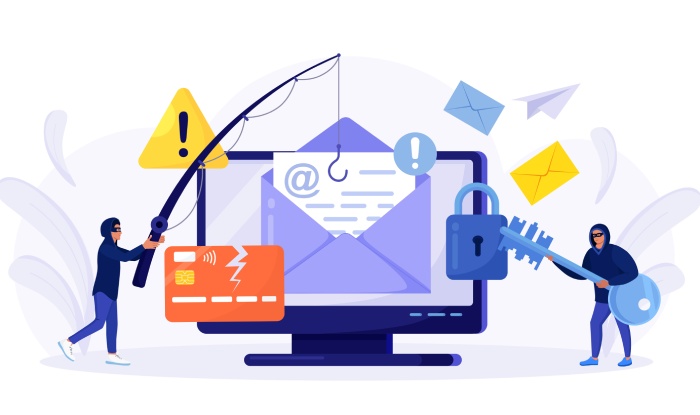A study by Forbes concluded that there could be up to 3.1 billion domain spoofing emails being sent daily. The most common understanding of spoofing is associated with email spoofing. However, domain spoofing is a more significant threat to organizations. Furthermore, many organizations are unaware of how it can hurt business and how anti-phishing solutions and anti-ransomware solutions can protect them from spoofing.
Domain spoofing is a phishing technique that involves an attacker who abuses an organization’s domain to impersonate it or any of its employees and misleads the victim for malicious gains.
Spoof domains created by altering the characters in the name of any legitimate organization’s domain are one of the techniques employed in phishing email examples. It can include an alternative spelling of the organization’s domain that looks very similar to the original one. Additionally, it could involve a change of domain or website suffix such as ‘.com’ instead of ‘.gov.’
Types Of Domain Spoofing
There are two main types of domain spoofing, classifying broadly, namely, URL spoofing and email spoofing. Below is more information on each class.
URL Spoofing
In URL spoofing, attackers spoof the URL of the website and try to pass off one website as another similar-looking one. They build a website with similar graphics and URLs so that the victim can mistake it for the genuine site and fall for the trap easily, eventually revealing sensitive information. URL spoofing also includes a homograph attack where the malicious actor uses characters from other languages or even numerical characters to resemble the original characters of the original URL. An example is to use zero (0) instead of the letter’ O’. Such websites are used to further the phishing activities of malicious actors, emphasizing the need for anti-phishing solutions.
Email Spoofing
In email spoofing, attackers trick the victims into thinking that a particular email has been sent from a genuine domain when it is sent from a fake one. Simply put, the malicious actor uses a malicious email address incorporating a slightly altered name of the original website’s domain. This technique is possible because domain verification is not part of the email protocol. However, new email phishing protection solutions include setting up DMARC and DKIM to verify the authenticity of the sender’s domain.
How Domain Spoofing Hurts Business?
Email spoofing and domain spoofing can mislead employees of an organization and make them victims of phishing. Domain spoofers use similar-looking URLs to lead victims into thinking that they are clicking on an authentic link. And when the employees are not adequately cautious to recognize and avoid clicking such links, they might expose personal and organization’s confidential and critical information to intruders. In addition, clicking on such links can also allow access for malware and ransomware into the information assets.
How To Protect An Organization From Spoofing?
It is not new information that malicious actors use 23 phishing emails every minute and launch a phishing domain every 5 minutes. Therefore, it is pertinent for organizations to be informed on protection from spoofing through anti-phishing tools, anti-ransomware solutions, and other safeguards and control measures mentioned below:
- Checking The SSL certificate: The SSL certificate encrypts traffic to and from the website. An external certificate authority verifies the ownership of the domain by the applying party and issues a digital certificate of authenticity. Hence, organizations and their employees must check the credentials of the URLs they visit.
- Adding An SPF record: An SPF, short for Sender Policy Framework, authenticates the sender of an email. An SPF record enables ISPs to verify the authorization of any mail server to send emails on behalf of a specific domain. It is a part of modern email protection solutions to prevent spammers from sending emails on behalf of an organization’s domain and protect against spoofing. In addition, it allows organizations to define which IP addresses can send emails using their domain. If the IP addresses don’t match the domain, it can block the emails.
- Adding A DKIM Record: A DKIM is a standard that protects email senders and their recipients from malicious attacks such as spoofing, phishing, and spamming. It enables organizations to offer authenticity for an email to prevent the delivery of spam. It adds digital signatures to the headers of email messages that a public key can validate. In simple terms, it provides an encryption key and signature to verify the authenticity of an email.
- Adding A DMARC Record: A DMARC record unifies both of the above records and mechanisms to enable domain owners to define an email’s handling of authentication failures. Furthermore, it also allows reporting from receivers to senders. This reporting enables domain owners to improve domain protection and monitor it against fraudulent emails. The study and implementation of SPF, DKIM, and DMARC can significantly benefit organizations in stopping phishing emails.
- Educating Employees: An email protection system consisting of the above mechanisms is a great way to protect an organization from spoofing threats. However, training and creating awareness among employees on using anti-phishing tools efficiently will protect an organization from being vulnerable to such threats. Furthermore, the threats posed by a phishing email can have tragic consequences, as 90% of data breaches are caused by such emails. Hence, well-informed employees are a key to enhanced protection in any organization.
Final Words
Equipping an organization and its employees with advanced tools in cybersecurity goes a long way in creating a culture of cybersecurity awareness. Such awareness encourages a proactive approach to cyber threats such as phishing, spoofing, and data breaches rather than a reactive approach. A single solution may not be able to fix all cybersecurity vulnerabilities of an organization. However, knowing to utilize the available resources in an optimum combination helps an organization keep a business’s domain secure from spoofing, phishing, and other cyber threats.



